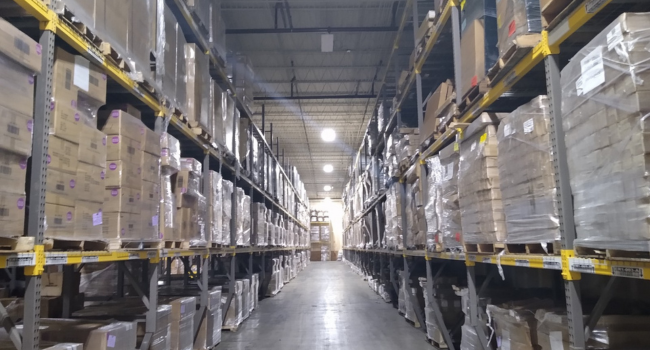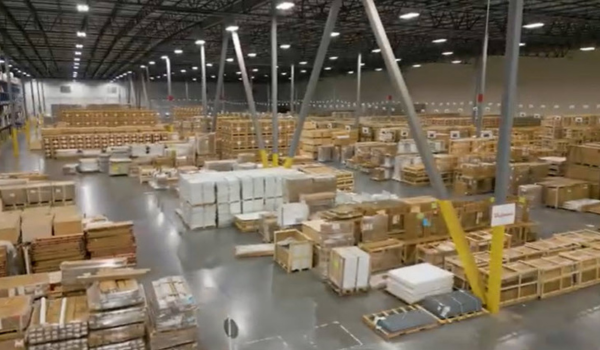When you have a wave of store projects coming up, what happens if a retail fixture manufacturer has to delay production? For many retailers, it throws a wrench into their carefully planned schedule and ultimately can lead to lost revenue.
But it doesn’t have to be that way. For instance, a major drugstore chain recently had around 250 store projects slated for the coming year. When one of their fixture manufacturers ran into serious production trouble, the retailer had a plan B that kept their schedule right on track.
“Because they use inventory consolidation services, they were able to avoid a chain reaction of project delays,” says Phil Vines, Director of Business Development for Store Opening Solutions.
Let’s take a closer look at how consolidating your retail fixtures can significantly improve how you handle a surge in store openings and remodels.
Check out this video to see two ways that retail fixture consolidation can improve how you handle a surge in store projects:
1. Prevent costly project delays (and desperate moves)
Retail fixture consolidation involves partnering with a consolidator who receives and warehouses the furniture, fixtures, and equipment needed for store openings and remodels.
Having a space designated specifically for fixture inventory storage means you can build up a reserve to prevent delays in your store schedule.

That’s how the drugstore retailer described above was able to avert disruption. “Rather than living and dying by perfectly timed factory-direct shipments,” says Vines, “they’d built up a safety stock to tap into. And the process worked exactly as it should.”
Moreover, when you have a safety stock to rely on, you’re not compelled to make desperate—and expensive—moves. “If your back is against the wall,” says Vines, “you could also try to source fixtures last minute from another vendor, at a much higher price, of course. But why put yourself in that position if you don’t have to?”
2. Stop missing out on fixture discount rates
Manufacturers typically won’t store your fixtures, which is one reason why retailers often opt for piecemeal ordering and just-in-time shipments to store sites. But this prevents you from saving significantly through bulk rate discounts or tiered pricing plans—a point especially true when you have a surge of openings or remodels.

Now imagine you have a slew of store projects coming up and available warehouse space thanks to consolidation. That combination of factors empowers you to consolidate orders, negotiate for larger volumes, and save money.
“Think about it like this,” says Vines. “Rather than buy one store’s worth of fixtures for $150K, you could possibly buy 10 stores’ worth for an average of $140K. Now, even with the consolidator’s fee, you’re still pocketing tens of thousands of dollars you’d never have in the first place.”
3. End the “nightmare” of trying to control hundreds of orders
With consolidation, the multiple vendors you use for fixtures and supplies all ship your orders to the consolidator’s warehouse.
Vines says this is a huge advantage, especially when you’re dealing with a wave of store projects in a compressed schedule. “Trying to track and manage hundreds of vendor orders, potentially around the country, so that they all arrive exactly when and where they need to—that can be a nightmare.”

On the other hand, consolidation simplifies and centralizes your processes. “Now you control the schedule and can ensure on-time deliveries by coordinating directly with one party, your consolidator.”
There’s also the added bonus of flexibility. “Even if you have to reshuffle schedules and orders, it’s now so much easier because you’re working with your consolidator. Changing up the timing or contents of shipments can be done with one phone call.”
4. Stop paying so much for transportation costs
A conventional approach to your store surge will mean coordinating production and shipment schedules with numerous vendors so they can send orders directly to store sites, ideally in a just-in-time fashion.
Unfortunately, a direct-to-store supply chain model relies on an LTL (less-than-truckload) network. “That’s going to mean paying for some amount of empty space, and you’d be surprised how much that can add up with dozens or hundreds of store projects,” says Vines.
But a consolidation approach minimizes LTL shipments. First, since you’re now able to buy in bulk volumes for multiple projects, you’re likely to have both more full truckloads and fewer overall shipments, which all go directly to your consolidator’s warehouse.
And when it’s time for the consolidator to ship to a project store site, you’ll likely be saving money with full truckloads once again. That’s because your consolidator can fill up a truckload with your fixtures and with the store supplies you’re warehousing with them—everything from shopping carts to registers to entrance carpets.
How big of a deal is the full truckload factor? Vines points to an example where a major retailer saved around $300,000 over the course of 105 store projects.
5. Solve the agonizing waiting game by ordering sooner
Let’s say you’re a buyer and you know from leadership that 50 new stores will be built and 150 stores will be remodeled next year. The problem is that it may be a while before you know exactly when and where these projects will take place.
With a conventional approach, you may be waiting (and waiting) with an anxious eye on the calendar as the schedule is firmed up because you know you need to build in enough lead time for fixtures to be produced.
But with consolidation, you can possibly start ordering before the project sites and schedule have been nailed down. “If you have standardized store layouts, if you know how many gondola runs there are and things like that, you can place your orders at the first of the year and have them sent to your consolidator,” Vines says. “Now your fixtures are ready when you are.”
Growth is good, but smart growth is even better
Opening new stores and remodeling existing ones signals an exciting time. After all, it means you’re growing! That said, as a retail expert you know as well as anyone that there’s a difference between growth and smart growth.
You’ve just gotten a glimpse of how retail fixture consolidation can greatly improve how you handle a surge of store projects. With so many potential fixture-related challenges in play today, now could actually be the perfect time to start building a new system—and an inventory of store fixtures and supplies.
Store Opening Solutions can help. For nearly 30 years, our consolidation services have helped some of the biggest names in retail transform their store project programs and grow much more effectively. Be sure to contact us to start a conversation.
About Store Opening Solutions
We support the strategic vision of retail organizations with focused expertise in the consolidation and installation of store fixtures and equipment. Our dedicated team embraces your vision and partners with you to create appropriate inventory control processes.







